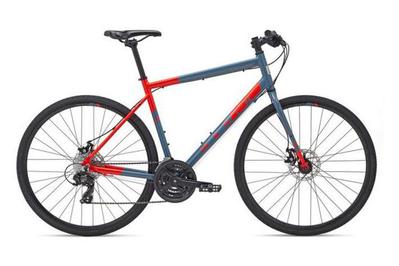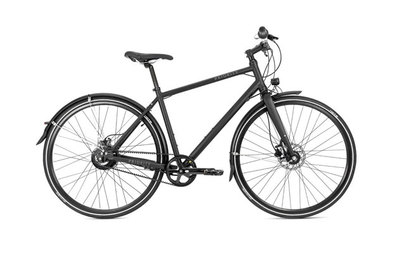If you’re looking for a bike for your daily commute and for your weekend exercise, a fitness hybrid—that is, a road bike with flat handlebars—may be the right choice.
Over the past six years, we’ve spent 60 hours sifting through nearly 75 options, test-ridden more than a dozen bikes, and concluded that the Marin Fairfax 1 is the best hybrid for most people. It provides a stable, comfortable ride on city streets, and it’s a better value now than when we first tested it.
These days, global supply chains have mostly recovered from their pandemic-related problems, and many bike companies are now facing inventory gluts rather than shortages. However, the list prices that rose during that time haven’t generally come down, at least not permanently. We are seeing discounts on bikes this summer, so it’s worth shopping around for a deal.
Or consider getting a used bike—we have advice on how to buy secondhand gear, including bikes, online without being scammed. Sites such as BicycleBlueBook and The Pro’s Closet sell used bikes; both require sellers to provide serial numbers for the bikes. (The Pro’s Closet specializes in higher-end bikes—that is, those costing at least $1,500 when new—and gives the bikes an inspection and a tune-up before selling them.)
One point that we’d like to underline: No matter who or where you’re buying a used bike from, ask the seller for the bike’s serial number so that you can see if the bike has been reported stolen. (Bike Index, a nationwide nonprofit registry, maintains a list of stolen bikes.) Don’t help bike thieves profit from their misdeeds.
Our pick
Marin Fairfax 1
This fun-to-ride and capable commuter bike is equally comfortable on longer weekend outings—and it offers far better value than its competitors.
Buying Options
*At the time of publishing, the price was $500.
Our top pick, the Marin Fairfax 1, ticks most of the boxes on our hybrid-bike checklist: durable-enough components, a chrome-moly steel fork that’s forgiving on potholes and rough city streets (and higher quality than the high-tensile steel forks used on many other bikes that cost more), rack and fender mounts, and hill-friendly gearing (including a rear cassette, rather than a cheaper and outdated freewheel cogset). When we first tested this bike, it earned extra credit for its well-designed aluminum frame, which provided more-agile handling and zippier acceleration than the competition. Marin has since revamped the frame to make the bike more stable and possibly less sprightly (we couldn’t detect a difference when we rode it). However, given the growing price difference between the Fairfax 1 (it’s $500, the same as it has been for the past couple of years) and similarly equipped bikes from other companies, we believe it’s still the best option, despite any possible downsides to the redesign. (The Fairfax 1 is available in a step-through option at the same price.)
Also great
Jamis Coda S2
This steel-framed bike provides a vibration-dampening ride and some nice extras—brand-name tires and sturdy pedals. But the trade-off is less maneuverability and a steepish uptick in price.
The Jamis Coda S2 is a very good option if you’re looking for the comfort of a steel frame (steel does a much better job than aluminum at dampening the vibrations caused by rough pavement) without the weight penalty that lower-priced steel frames often impose. (Such frames are often made with heavier high-tensile steel, rather than the chrome-moly that the Coda S2 has in both its frame and fork.) That means an easy time carrying this bike up stairs and lifting it onto bus- or car-mounted bike racks. The Coda S2 comes with well-rated Vittoria Randonneur tires—that is, tires from a “real” tire company that you can buy in a bike shop, and now in a wider and cushier size—and steel-wrapped resin pedals. (This bike is also available in a women’s version, which essentially means smaller sizing and a women’s-specific saddle.) The main drawbacks with this model are maneuverability—it’s not quite as nimble as the other bikes we tested, which could be a function of its geometry (we’ll get into that in the How we picked and tested section)—and price. In 2018, the Coda Sport (as it used to be called) cost $530; now, the Coda S2, which has very similar components, costs $770.
Upgrade pick
Priority Continuum Onyx
A belt-drive bike that has an easy-to-use internally geared rear hub means less maintenance and no grease on your work clothes. You have to assemble it yourself though (or pay someone else to).
For commuters, belt-drive systems make a lot of sense: The belts don’t wear out as quickly as chains; they don’t need to be oiled, so there’s less bike grease in your life and on your clothes; and the internally geared rear hubs let you change gears when you’re standing still (like at a traffic light). The downside is cost: Reliable internally geared hubs are expensive, which in turn makes bikes with belt drives pricier than our other picks. The aluminum Priority Continuum Onyx is, however, a bargain for this category, especially considering that it comes with hydraulic disc brakes, the well-respected Gates Carbon Drive belt, and an Enviolo continuous gearing rear hub, plus upgrades such as internal gear cable routing and dynamo-charged front and rear lights. (This bike does not, however, come in a step-through version.)







